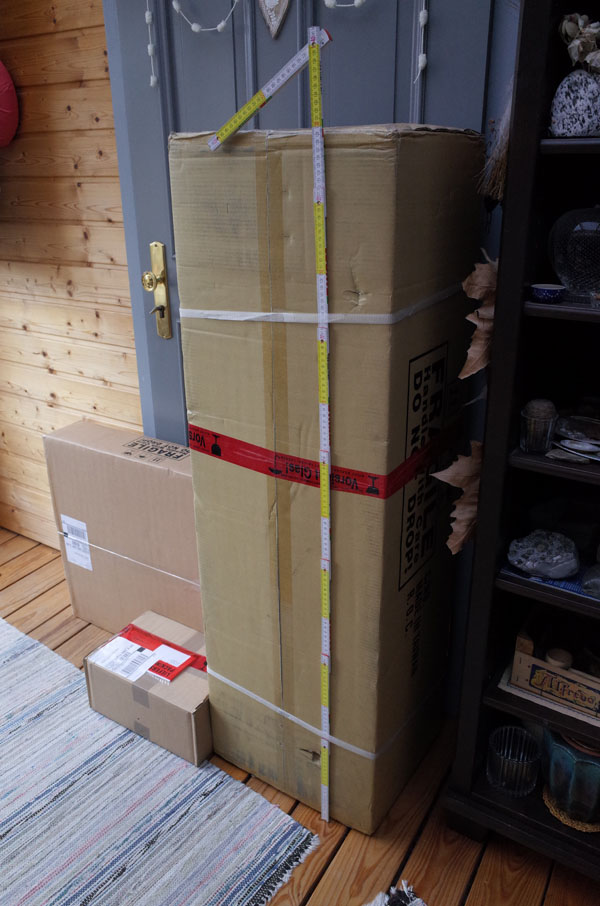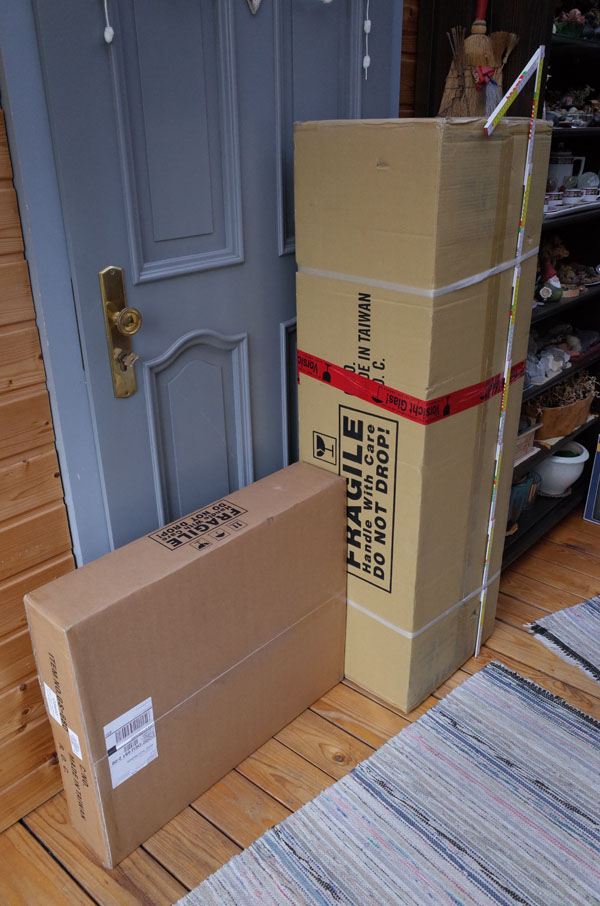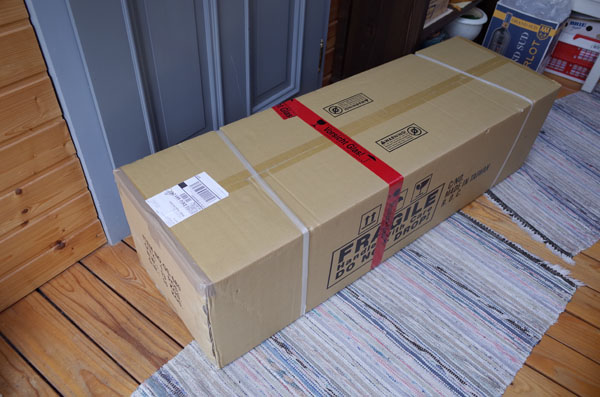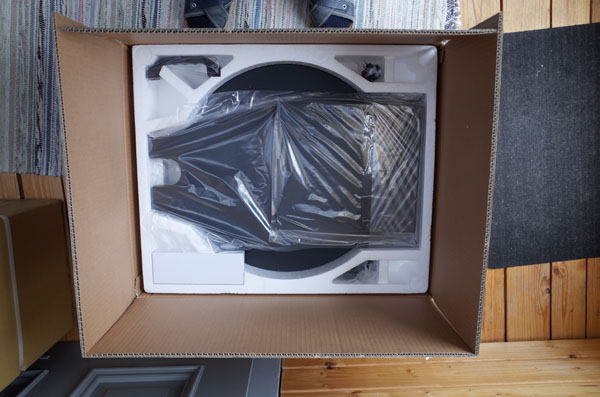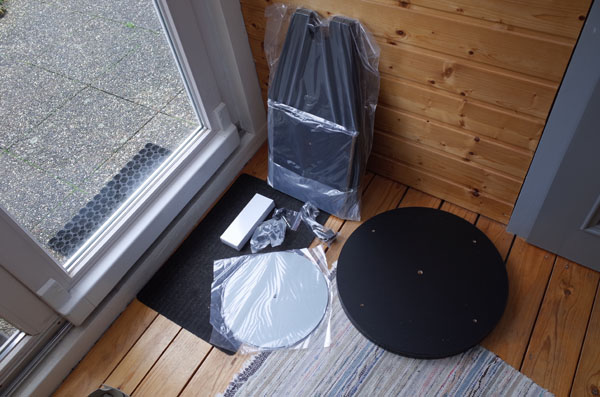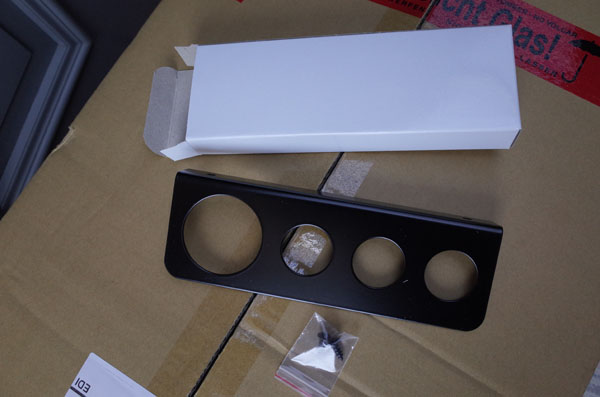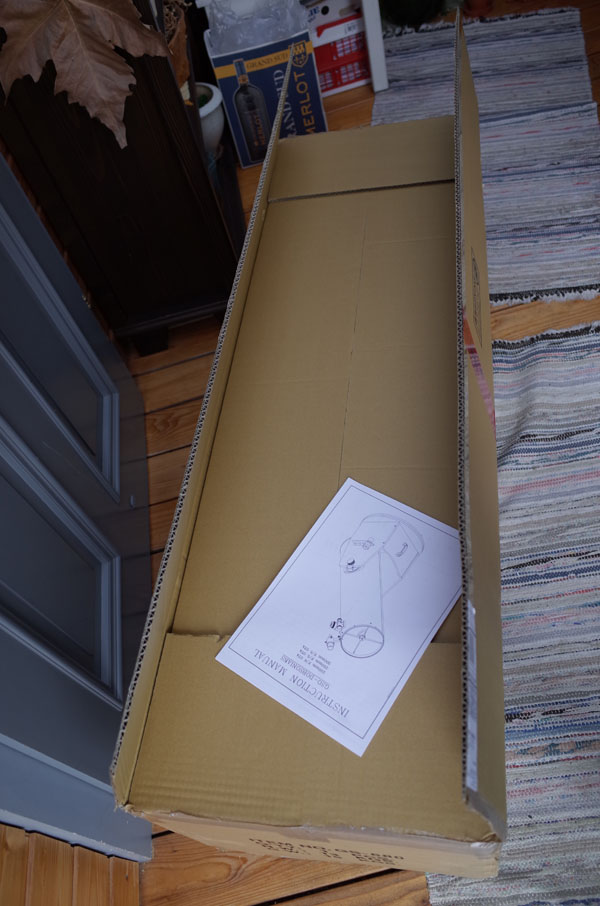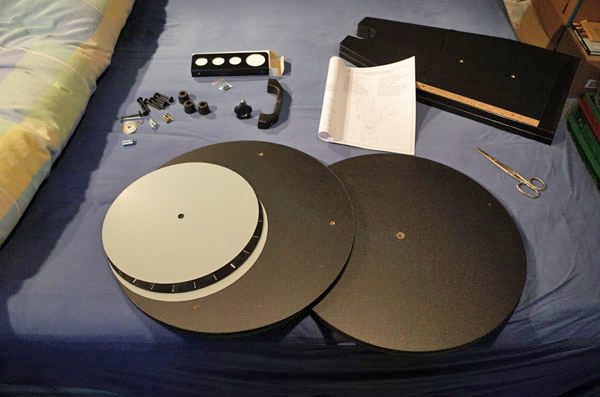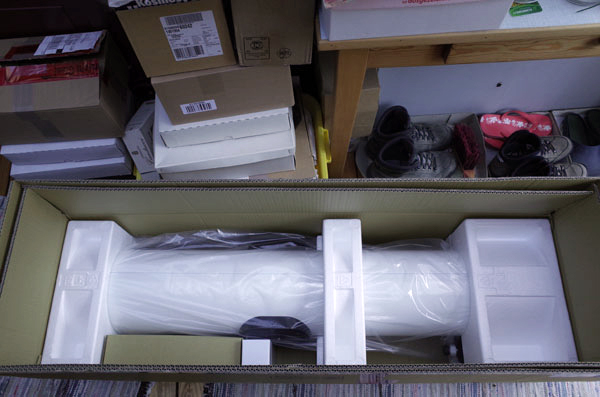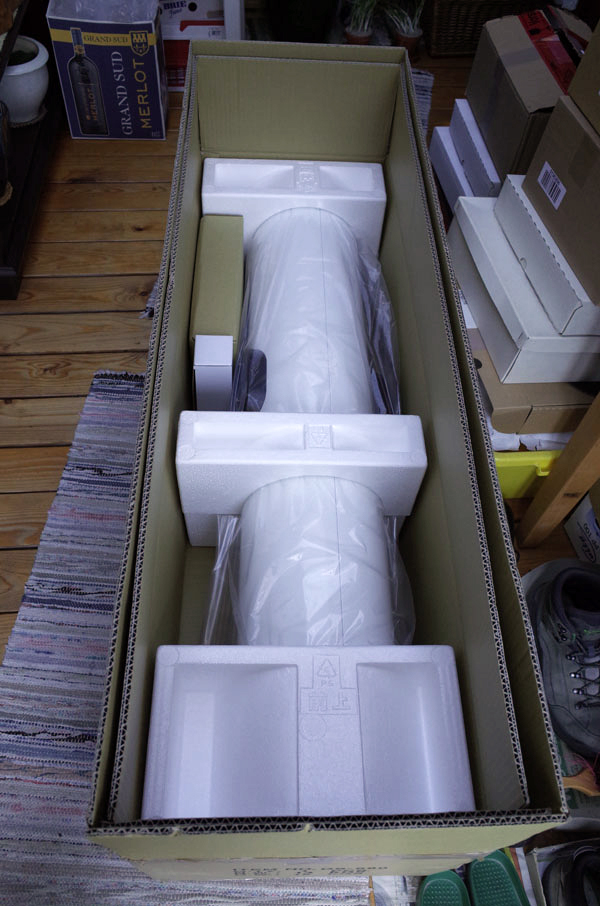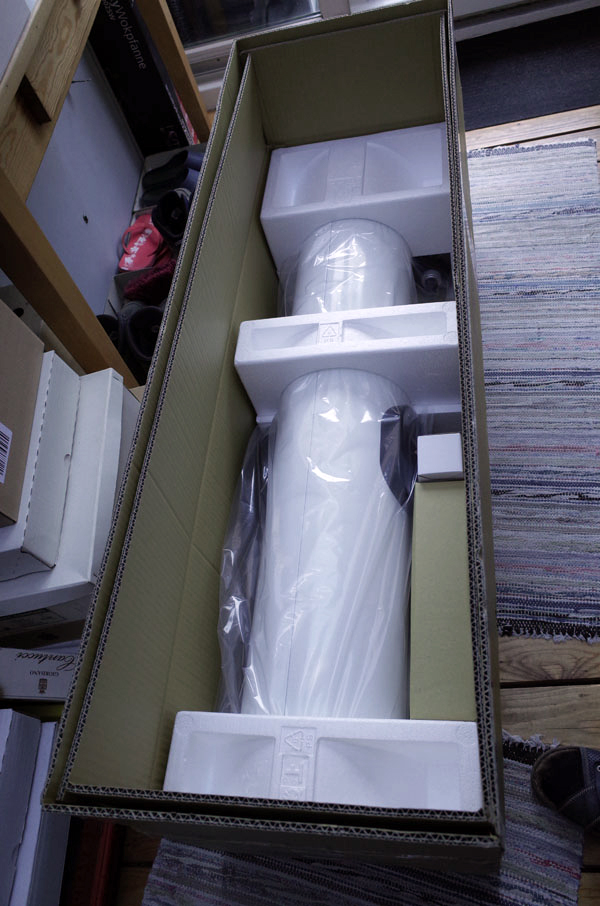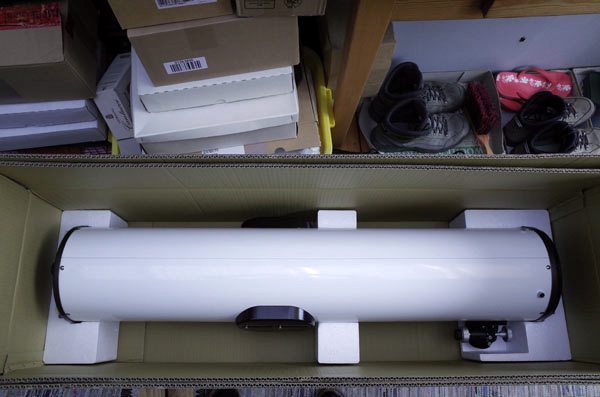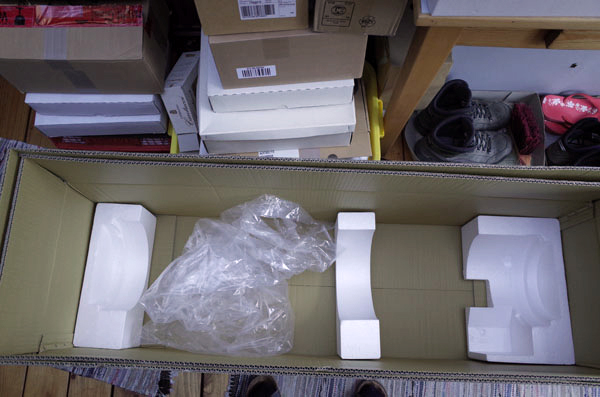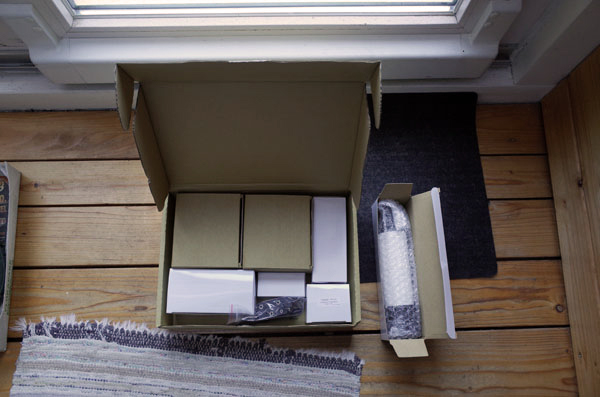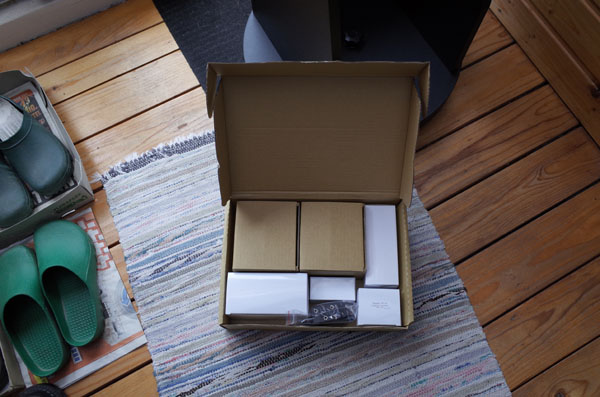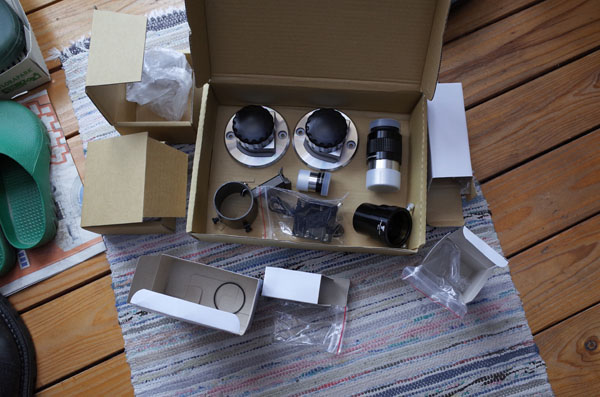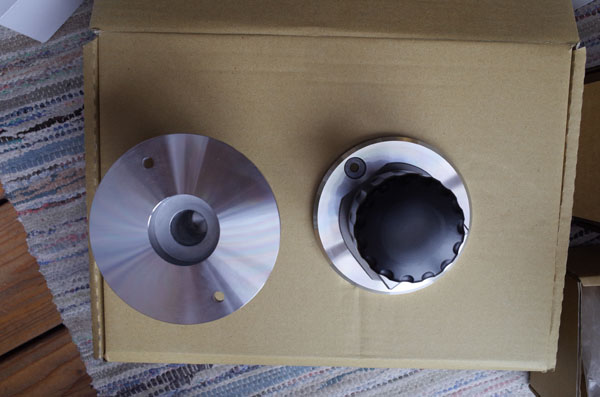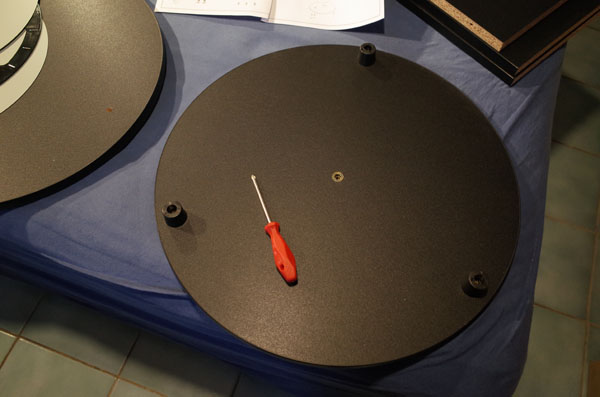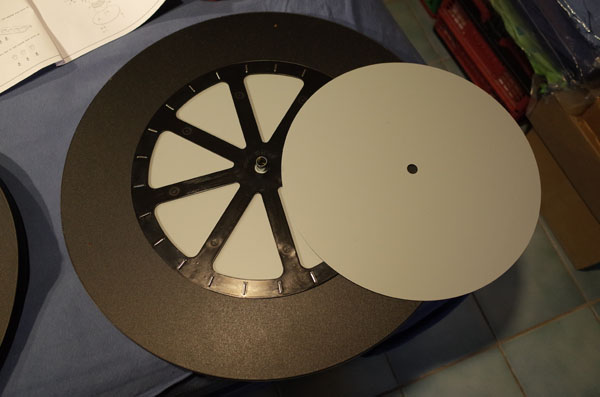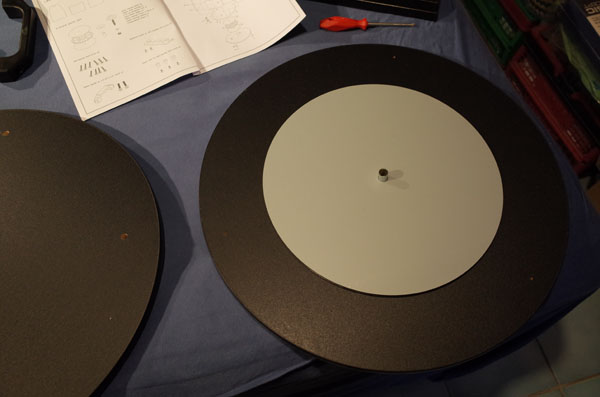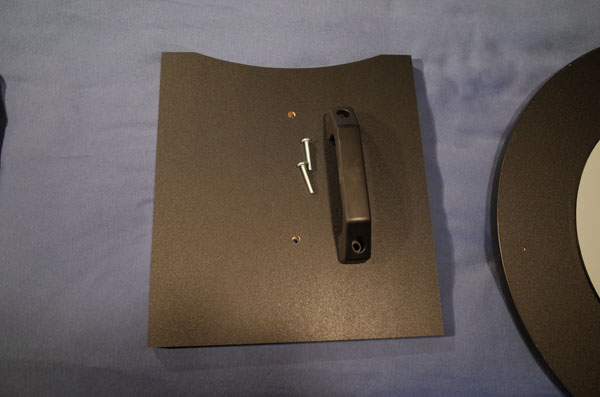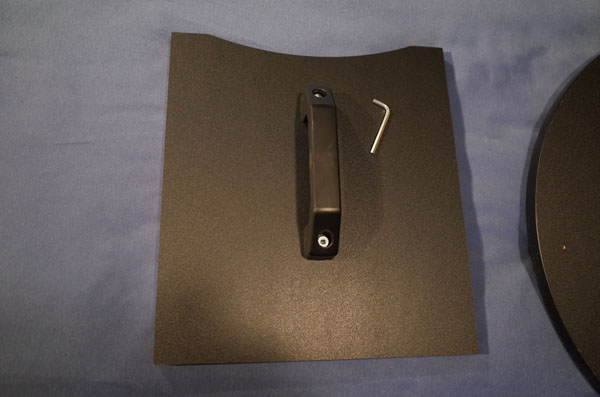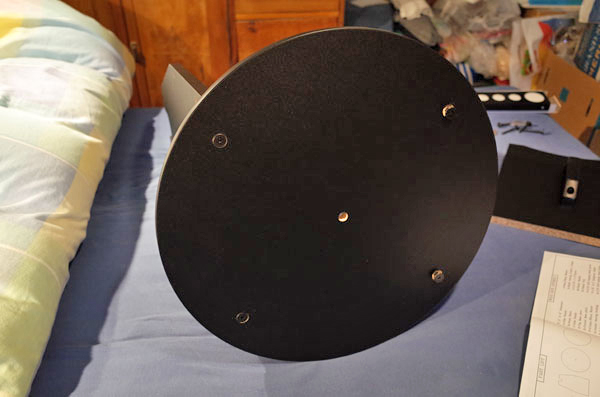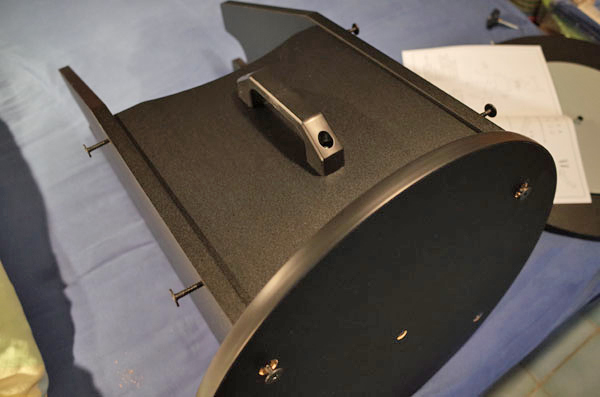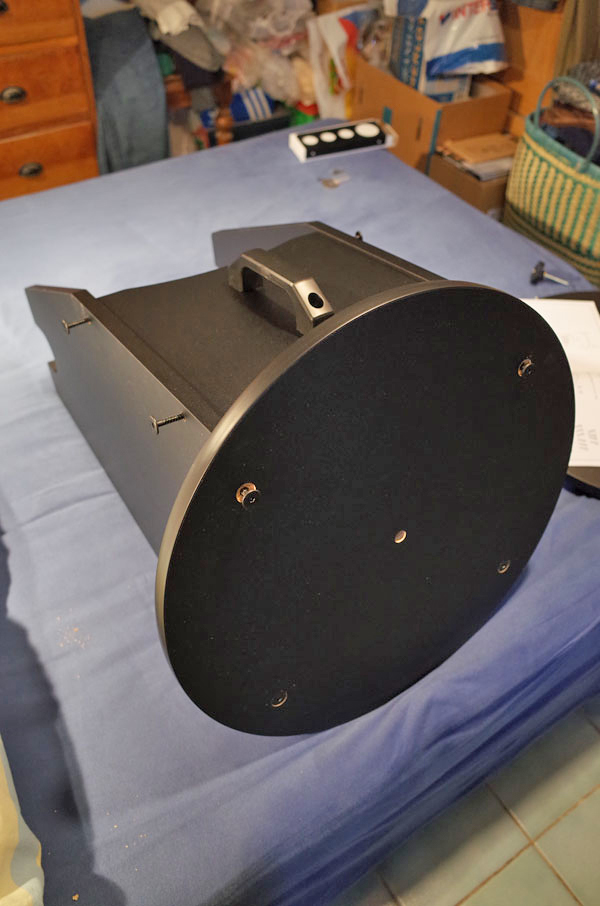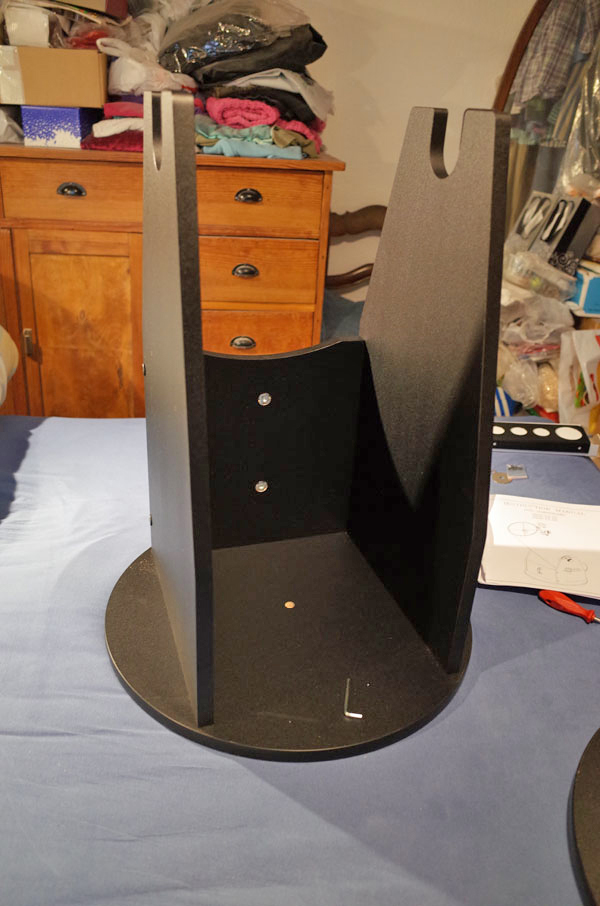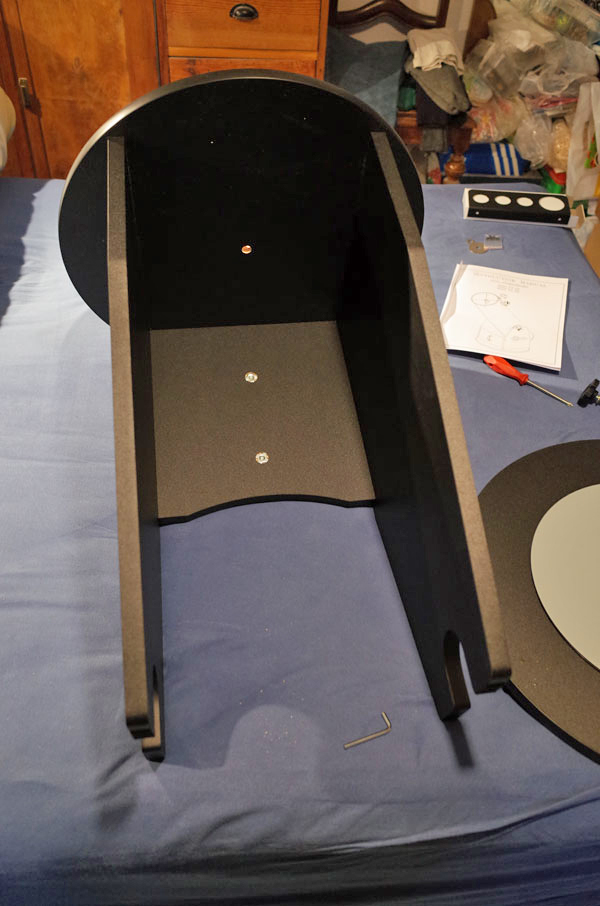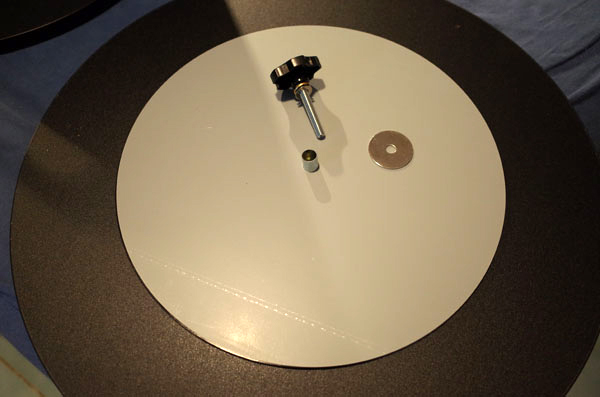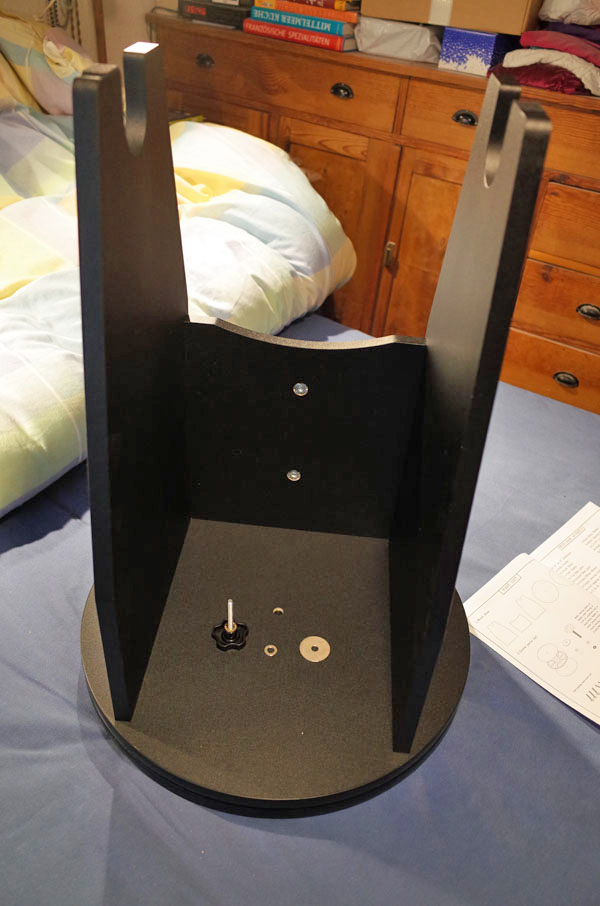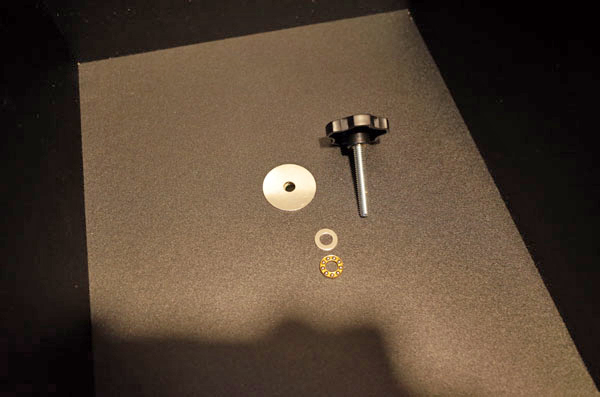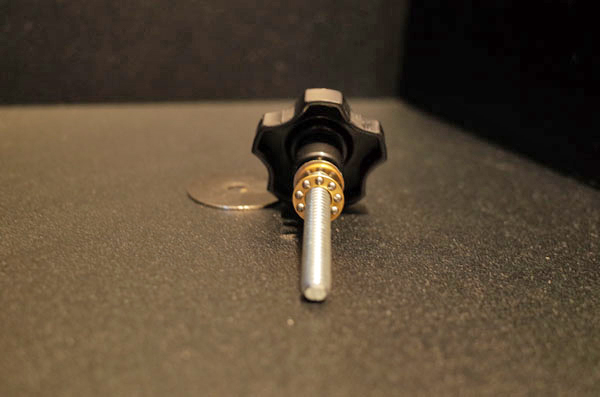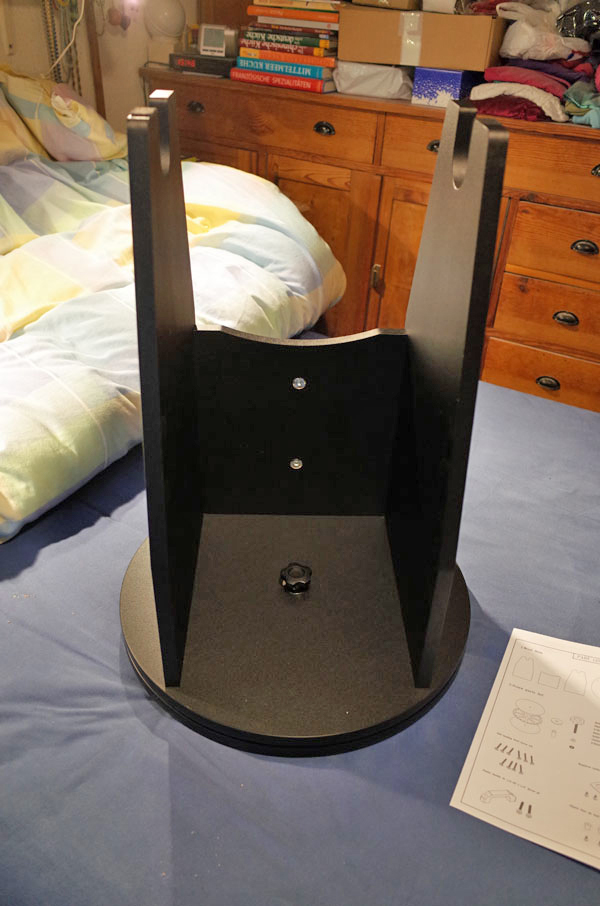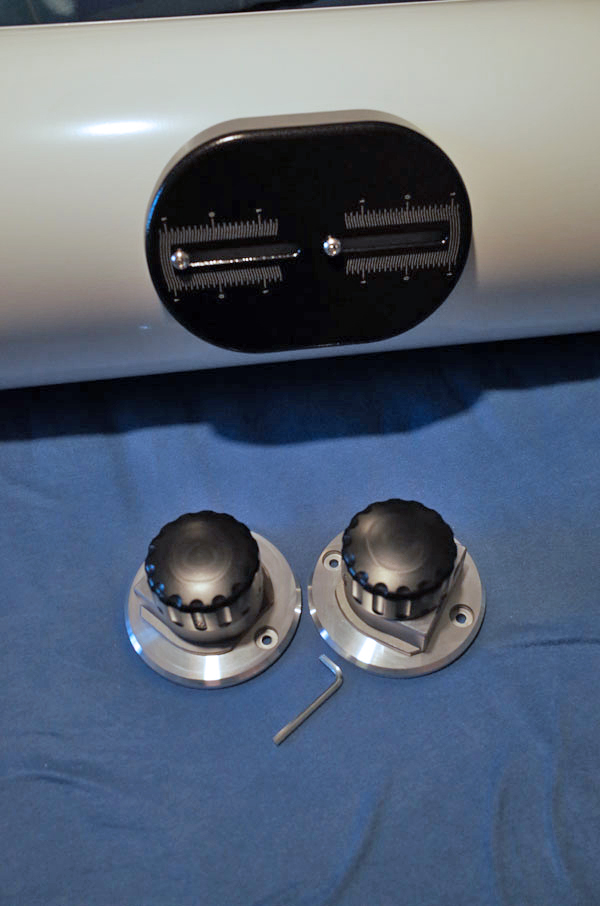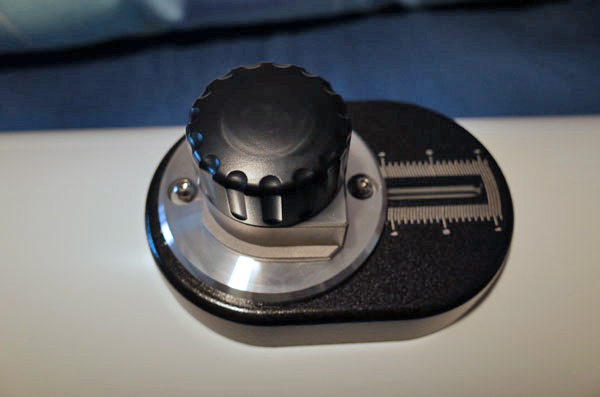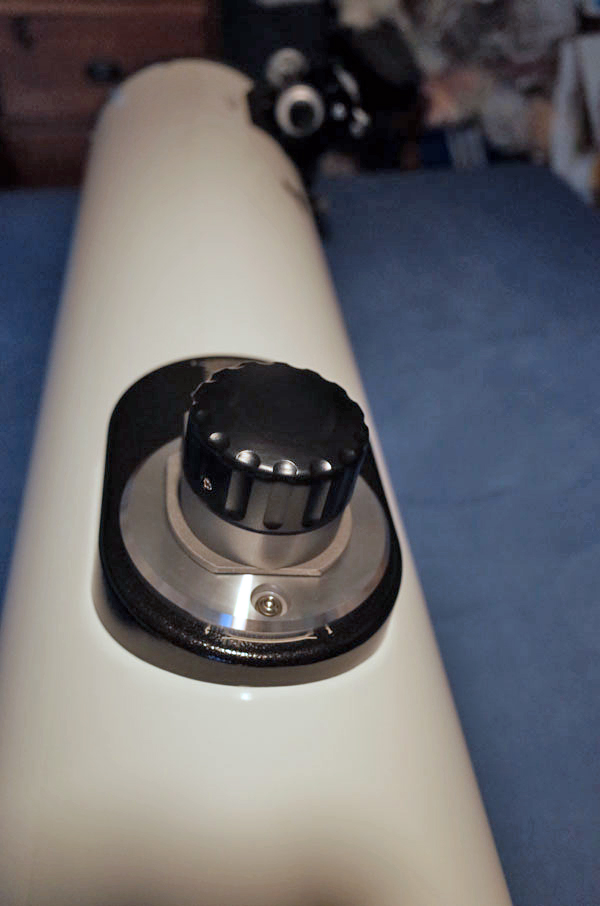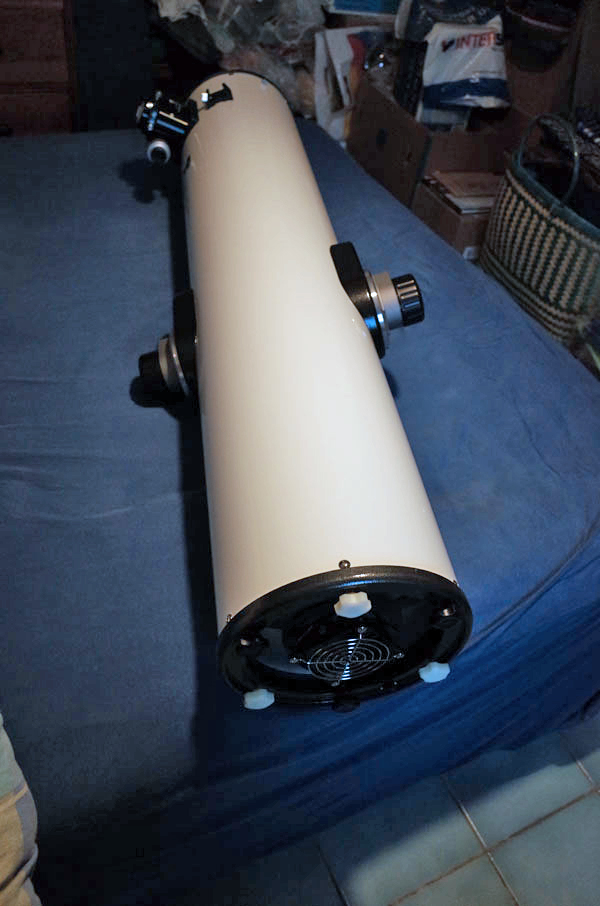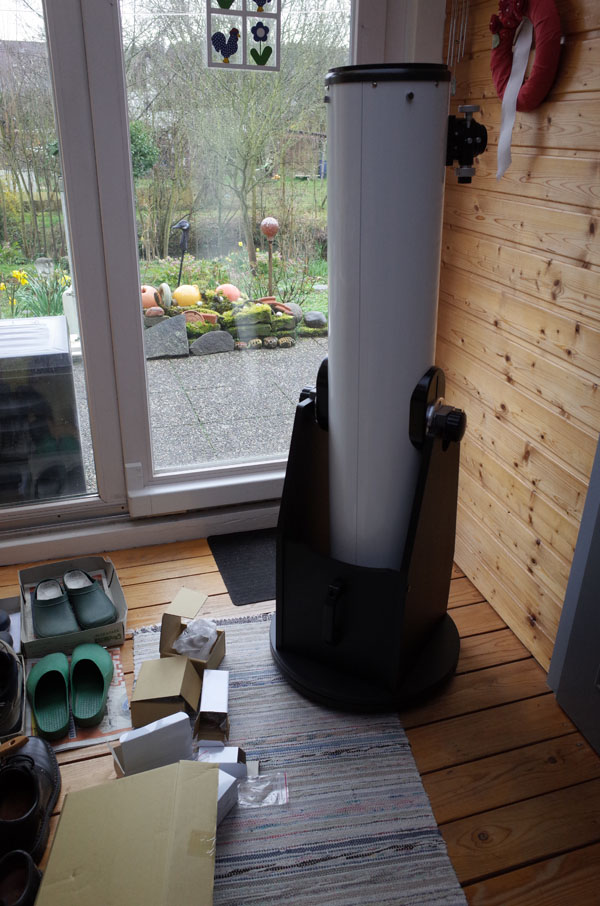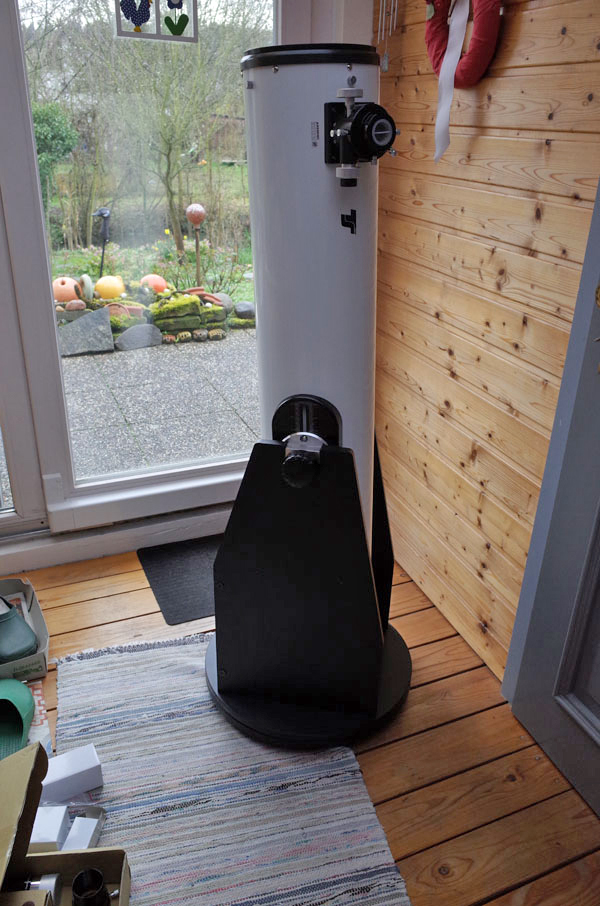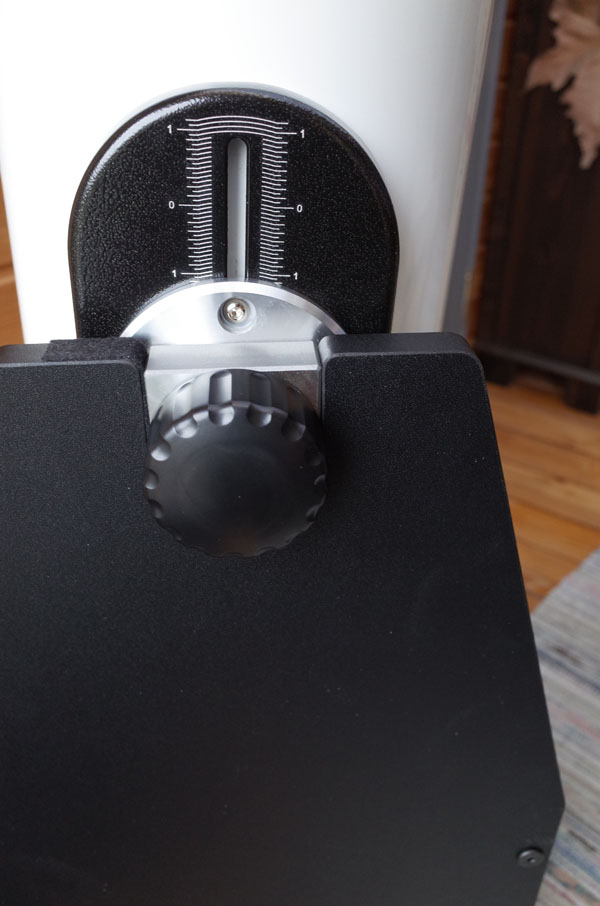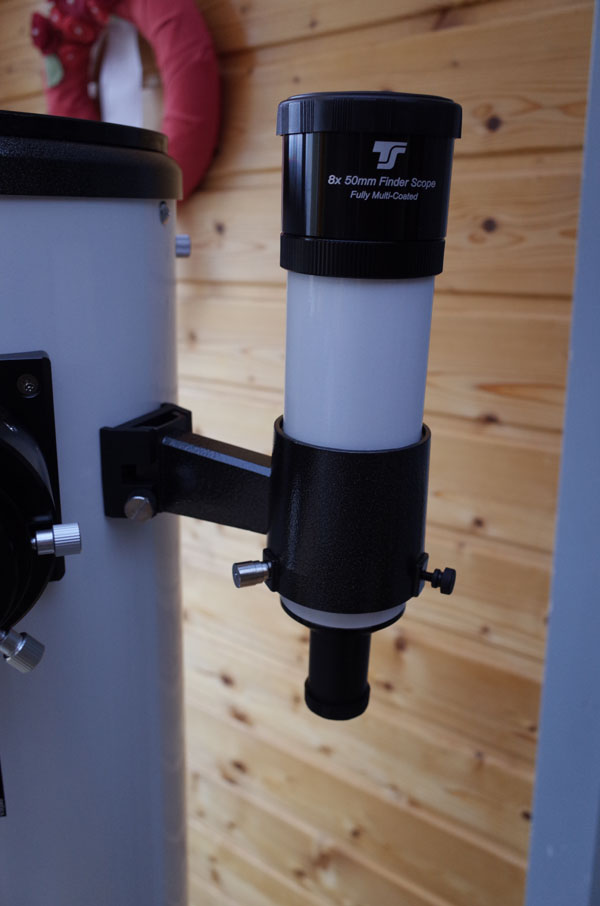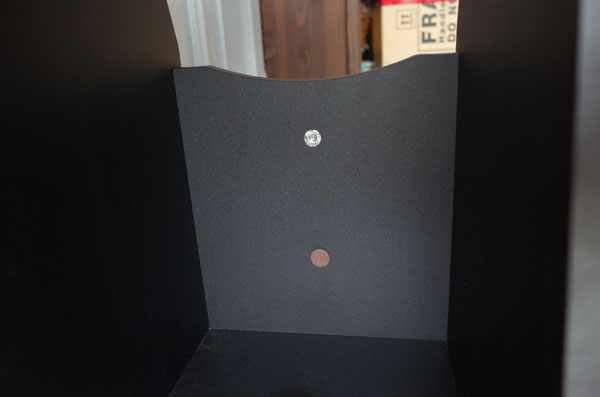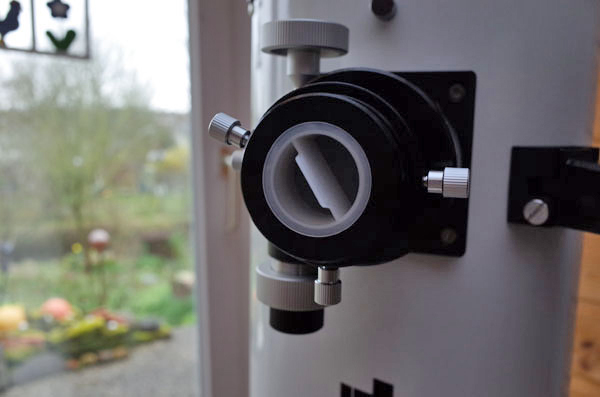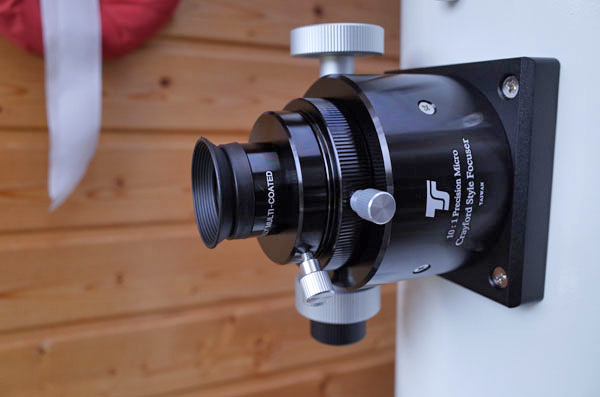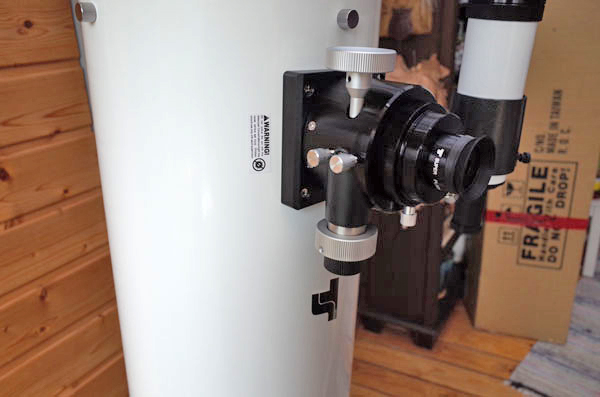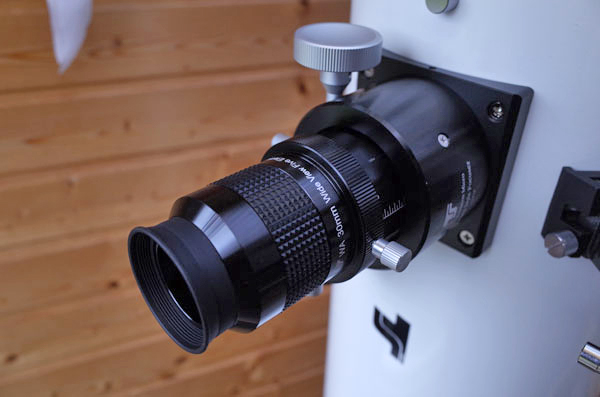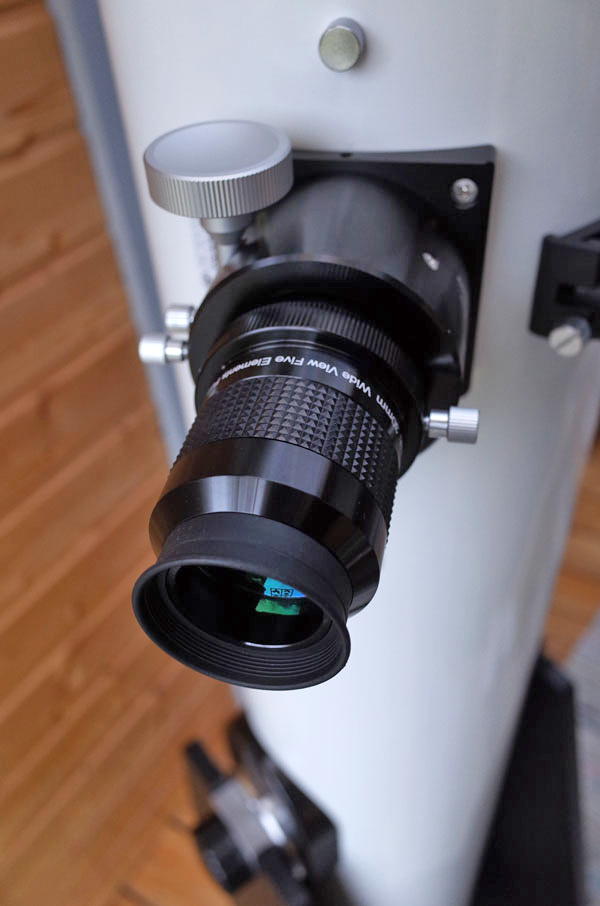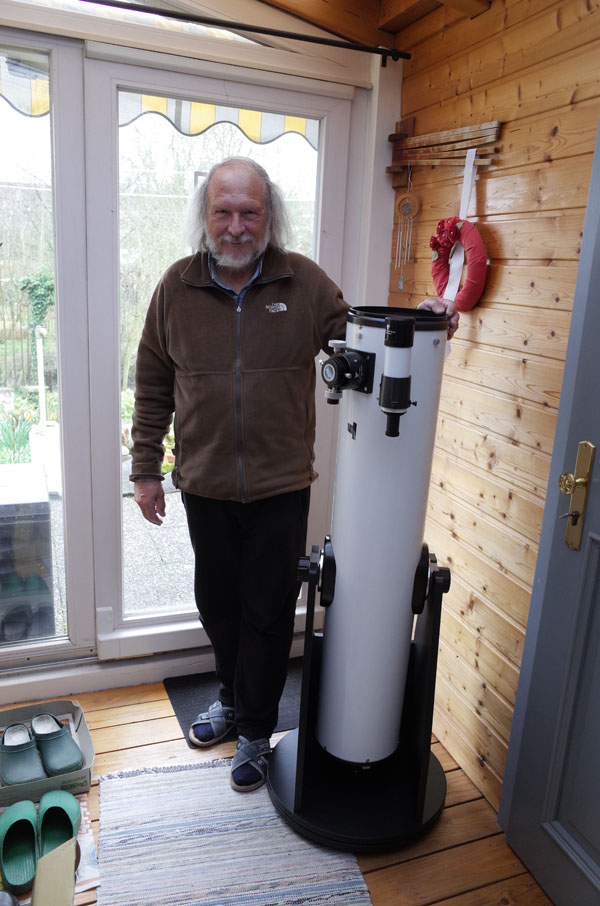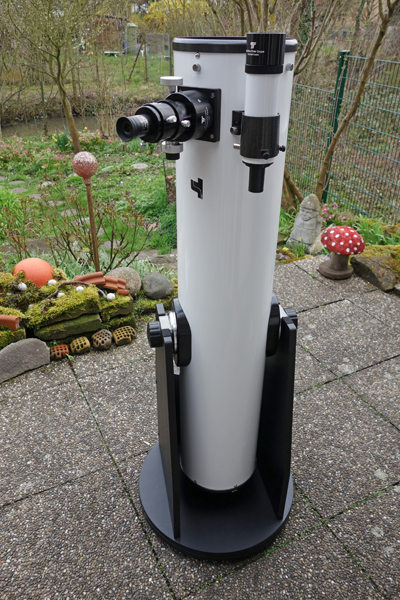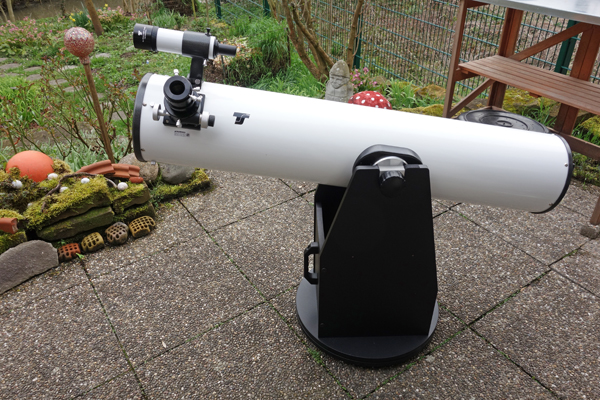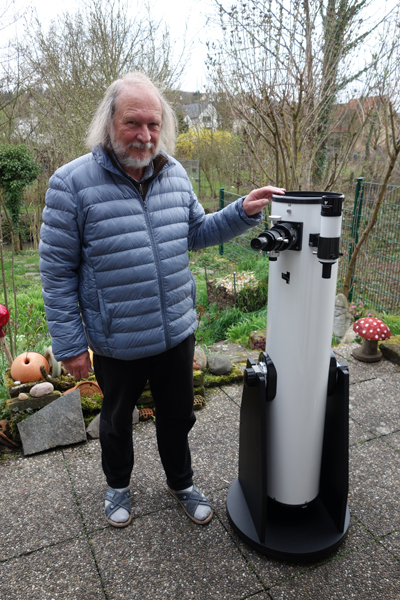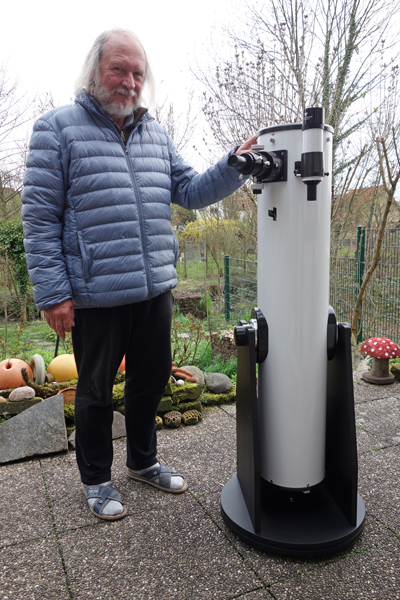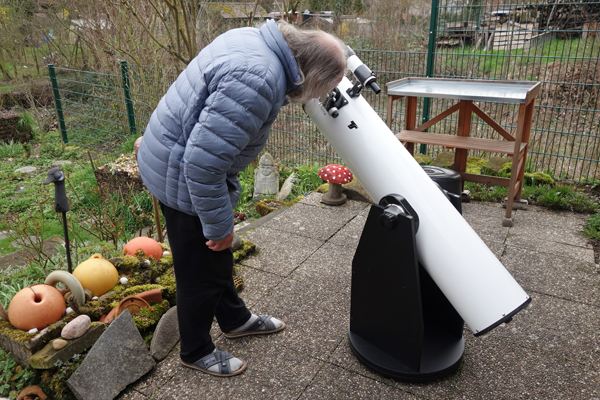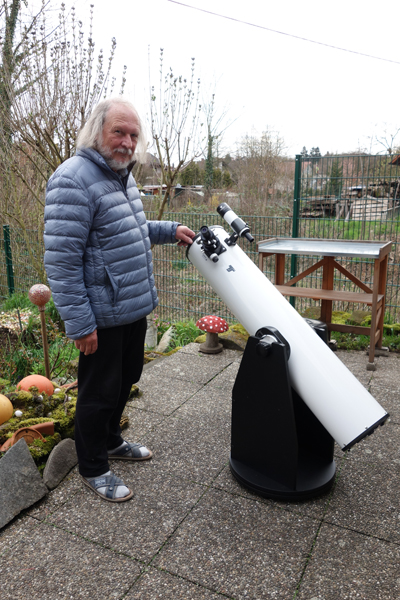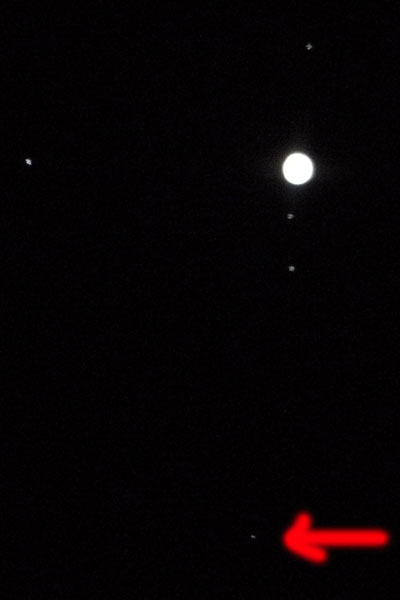GSO Dobson: GSD 680
Motivation | Unboxing | Assembly | Look | Visited Sky Objects | First Photo Attempts | Conclusions | Links | Appendix: Data
Archive
On this page I present some information about my second "big" telescope, a GSO GSD 680 Dobsonian Telescope with 8" aperture (purchased end of March, 2016). It is the" De Luxe "version of the GSO 200C Dobsonian telescope. I bought it as a replacement for my 10" Meade Lightbridge Dobsonian telescope, which had become too heavy for me.
As I have read many times, the 8" Dobsonian telescope with f/6 (i.e., with 1200 mm focal length) is nowadays the "classic "entry telescope for the more ambitious astronomy hobbyists. Some will stick to it for a lifetime, but many others are addicted aperture, and will buy larger and larger telescopes. Previously, the 6 " Dobsonian with f/6 (i.e., 900 mm focal length) was the starter drug, but that seems to have changed...
At the beginning, it was open to me, how this journey would end. But actually, I had started "scaling down" from 10" to 8" to 6"... The GSD 680 also proved to be too heavy for me, and after one year, I switched to a 6" tube...
See the appendix for the data.
Note: Seems to be more or less identical to the Bresser Revelation 8" f/6 M-CRF Premium Dobsonian telescope.
| Note: I bought a 6" Newton tube in April 2017, because the GSD 680 was still too heavy for me. I therefore gave it to a dealer to sell it for me (sold in the meantime). I therefore can no longer report any further experiences with this scope here. |
Motivation
Why did I buy the GSO GSD 680 Dobsonian Telescope with 8" aperture and for what purpose? After realizing that my Meade 10" LightBridge telescope was too heavy for me (12.2 kg and 17.2 kg, about 31 kg in total), I sold it in February 2016. This was done with the intention of replacing the LightBridge with a slightly lighter 8" Dobson telescope, and in the hope that I would be able to manage its weight. After researching the market, I chose the GSD680 (12.2 kg and 9.5 kg, approx. 21 kg in total) from GSO, which received good reviews. This was at the end of March 2016. I also chose the de luxe version, which offers, among other things, a 1:10 dual speed microfocuser. I am sure that a Dobson from Sky-Watcher or some other brand would have doneit as well. The GSD680 delivered very nice results, maybe even better ones than the Meade Lightbridge. But because I had sold this telescope before I bought the GSD680, a comparison was unfortunately not possible.
In the long run, however, the GSD680 became too heavy for me as well, and I began to look for something lighter. Since I had meanwhile purchased a Star Discovery GoTo mount, which of course was not able to carry the heavy 8" tube, I was not looking for a 6" Dobson telescope this time, but for a 6" Newton tube, which was light enough to fit my GoTo mount. In such a case, all my tubes would have been "GoTo-capable". I found the desired tube in the Sky-Watcher Explorer 150PDS, assuming that it weighs only 5 kg, which my Star Discovery GoTo mount should just carry. This was regrettably not the case, but that is another story... A brief comparison between the 8-inch and the 6-inch models brought advantages for the 8-inch model, as expected. But after hesitating for a moment I parted with the GSD680 and brought it to my dealer for selling it for me (it was sold).
Thus, the GSD680 was an intermediate stop on a longer journey from 10" via 8" to finally a modest 6" aperture! Usually, however, such journeys go in the opposite direction, that is, in the direction of larger apertures...
Unboxing
Boxes
|
Boxes (including box for Telrad finder) |
Boxes (including box for Telrad finder) |
Boxes |
|
Tube box |
Tube
box: Rockerbox box: (A dealer lists a total gross weight of 40 kg for the telescope) |
Weights: Sizes: |
Rockerbox Unboxing
|
Parts of the rockerbox in the box... |
...and outside of the box |
eyepiece holder (not used by me) |
|
The manual was hidden in the tube box ... |
Rockerbox parts put together before the assembly... |
...and with parts unpacked. The metal disks, that is, the roller bearing plates, go between the two wooden disks, that is, the base plates. |
Tube Unboxing
|
The opened tube box |
Ditto |
Ditto |
|
The complete tube can be seen now |
Tube without plastic foil |
Empty tube box |
|
Boxes with accessories and more... |
The 8 x 50 finder scope |
Box with eyepieces, side bearings, and more |
|
Accessories unpacked |
The side bearings |
Accessories: 9 mm and 30 mm eyepiece; 8 x 50 finder scope In addition, I bought: Telrad finder and deep sky atlas |
Assembly
Rockerbox Assembly
Note: I did not assemble the rockerbox in an optimum order. Only one day later, I found a video demonstrating the assembly of the 10" version: www.zhumell.com/telescopes/dobsonian/z8-dobsonian-telescope (Zhumell version; scroll the page for the video)
|
Ground base plate with attached plastic feet |
Ground base plate with roller bearing plates and plastic roller bearing |
Roller bearing put together with center bearing bushing attached |
|
To base plate from below; the screws for fastening the wood base are already in place. There are no holes for screws to fasten the front brace... |
The front brace before attaching the plastic handle... |
... and afterwards |
|
Now the side panels have to be attached to the top base plate. This was somewhat fiddly to do and to photograph... |
Now the side panels are in place but the screws are not yet tight. |
Finally, the front brace is added and all the screws are tightened. |
|
Another view... |
View of the nearly finished upper part of the rockerbox |
And another view... |
|
Now the two base plates need to be placed above each other. First, the roller bearing has to be put on the ground base plate and the roller bearing bushing added. Then the top part of the rockerbox is carefully put on top of all this (see next photo). |
Here, the upper part of the rockerbox is in place, and I need to add the adjustment bolt and two washers |
The adjustment bolt and the two washers in detail |
|
The adjustment bolt and the two washers in detail |
The assembled rockerbox - I did not attach the eyepiece holder |
Weights: Sizes: |
Attaching the Side Bearings to the Tube
|
Side bearings before attachment |
First side bearing attached |
Ditto |
|
Second side bearing |
Tube with side bearings attached |
Tube from below with fan and collimation screws (main mirror)
|
Look
Final Assembly
|
Tubes in rockerbox |
Tube in rockerbox - turned |
Tube in rockerbox - from the side |
|
Side bearings in use (wrong position) |
Finder Scope mounted |
Securing the tube against bumps (not delivered...) |
|
Crayford focuser with adapter for 1,25" eyepieces |
Crayford focuser with 9 mm Plössl eyepiece (1,25") |
Ditto; you can see the two screws for fixing the focuser. |
|
Crayford focuser with 30 mm Erfle eyepiece (2") |
Ditto |
Size comparison (1,70 m vs. 1,32 m) |
The next Day Outside...
Comparison with Heritage P130 and Heritage 100P
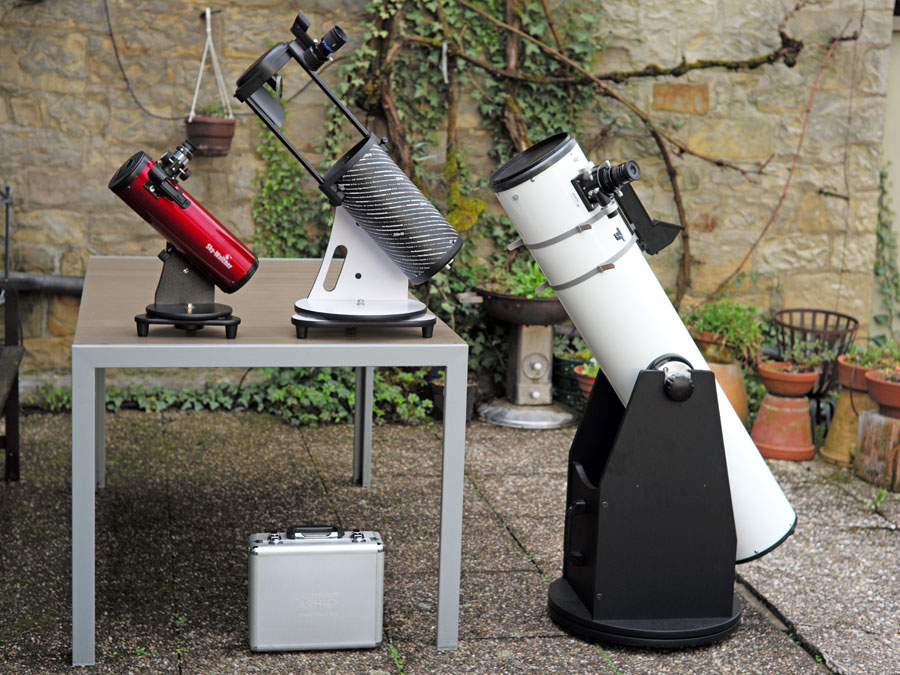 |
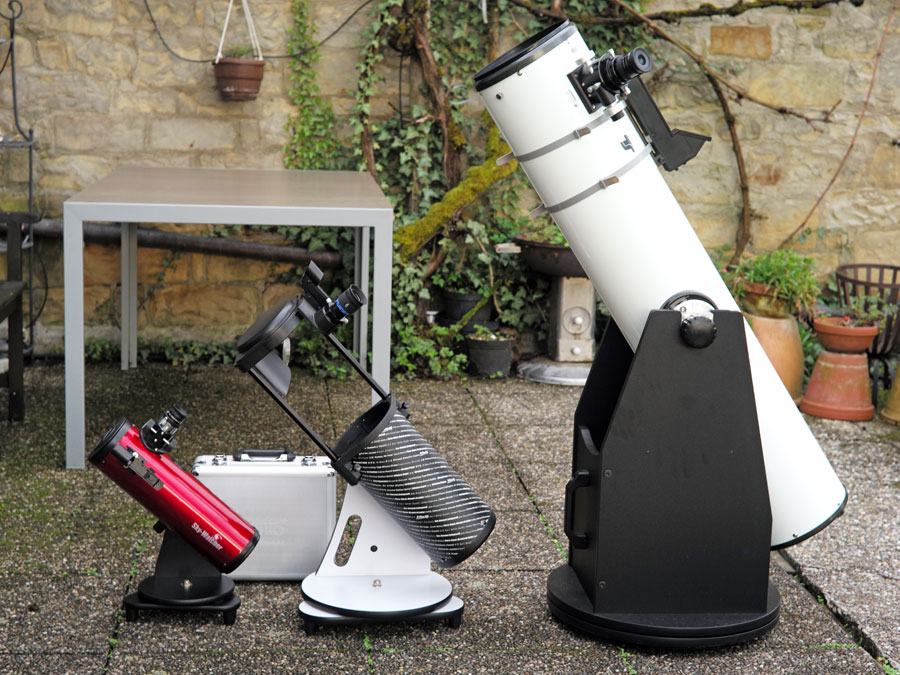 |
| Size comparisons with Sky-Watcher Heritage 100P and Heritage P130 | |
Visited Sky Objects
I visited (and documented...) the following sky objects with the GSO GSD 680:
- Moon
- Venus (crescent), Jupiter (with moons, stripes), Saturn (with ring)
- February/March/April: M 1, M 31, M 35, M 36, M 37, M 41, M 42/43, M 45, M 50, Mel 25, NGC 884/869, NGC 2362
- Autumn: M 13, M 92
This list is probably incomplete, because I did not document my observations well. But, at least, it shows, which objects can be found with this telescope. In addition, this telescope should be able to access all those sky objects that I listed for my smaller telescopes.
Highlights
- Planets: Venus (crescent), Jupiter (with moons, stripes; Jupiter 2016), Saturn (with ring)
- DSO (globular cluster): M 13, M 92
- DSO (star cluster): M 35, M 45, NGC 884/869
- DSO (nebulae): M 42/43
First Photo Attempts
Jupiter with Moons (April 7 & 10, 2016)
The following photos were taken with the projection method (camera lens mounted fix to a 32mm eyepiece, ISO 3200) using a Leica X Vario (the rightmost photo is from April 10, 2016):
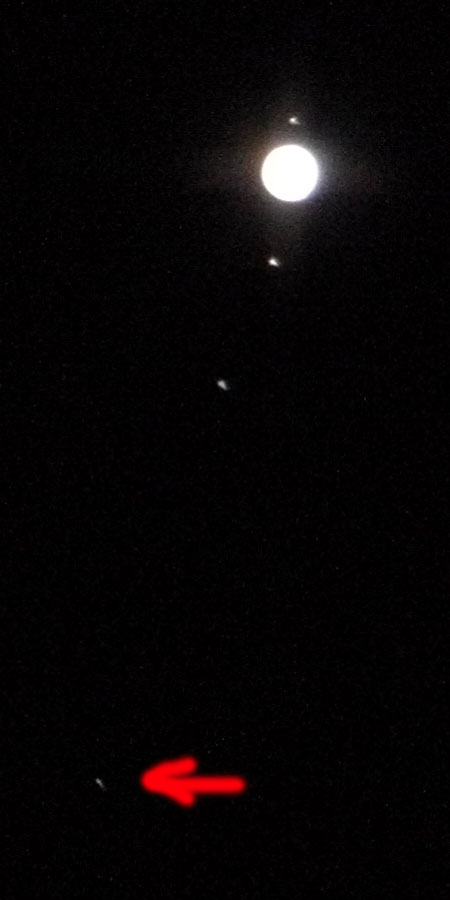 |
Jupiter (April 7, 2016)
The following photos were taken with the 1:50 method (camera lens held at an 9 mm eyepiece) and a Leica X Vario (ISO 3200). The photo sections were scaled down to 50% (looks better than 100%). Click the photos to see the sections at 100%.
| Original | Post-Processed | Converted to B&W | Original | Post-Processed | Converted to B&W | |
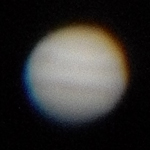 |
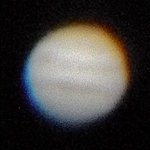 |
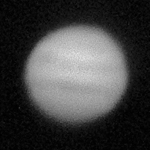 |
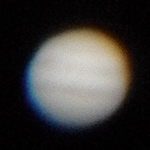 |
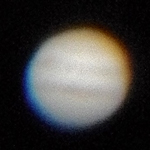 |
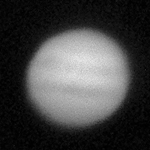 |
|
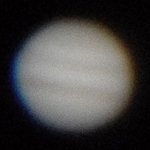 |
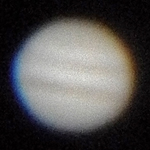 |
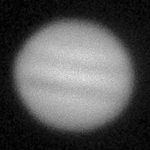 |
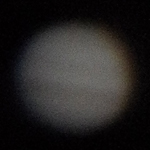 |
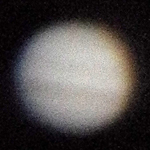 |
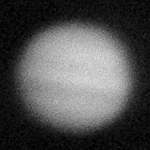 |
|
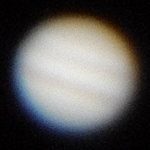 |
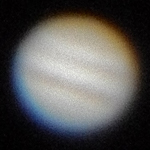 |
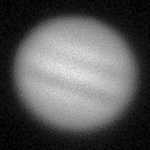 |
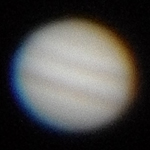 |
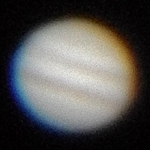 |
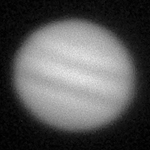 |
The following sections were scaled down to 25%, which makes them look even better:
| Original | Post-Processed | Converted to B&W | Original | Post-Processed | Converted to B&W | Original | Post-Processed | Converted to B&W | ||
 |
 |
 |
 |
 |
 |
 |
 |
 |
||
 |
 |
 |
 |
 |
 |
 |
 |
 |
Moon (April 10, 2016)
Photos with 32 mm DigiScope Eyepiece (Projection Method)
For the following moon photo attempts, I mounted the Leica X Vario fix to the 32 mm DigiScope eyepiece. The telescopic magnification was only 37.5 x, the camera lens was set to a focal length of 70 mm (= 46 mm actual) (I think...).
 |
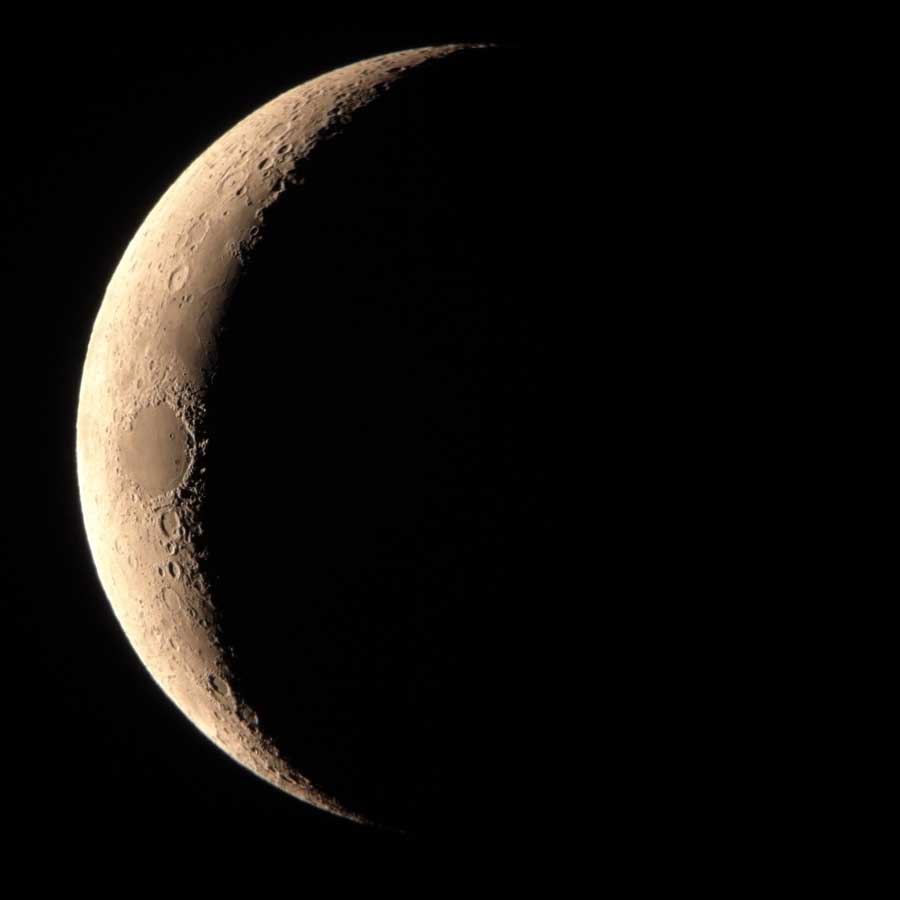 |
Enlarged Sections (100%):
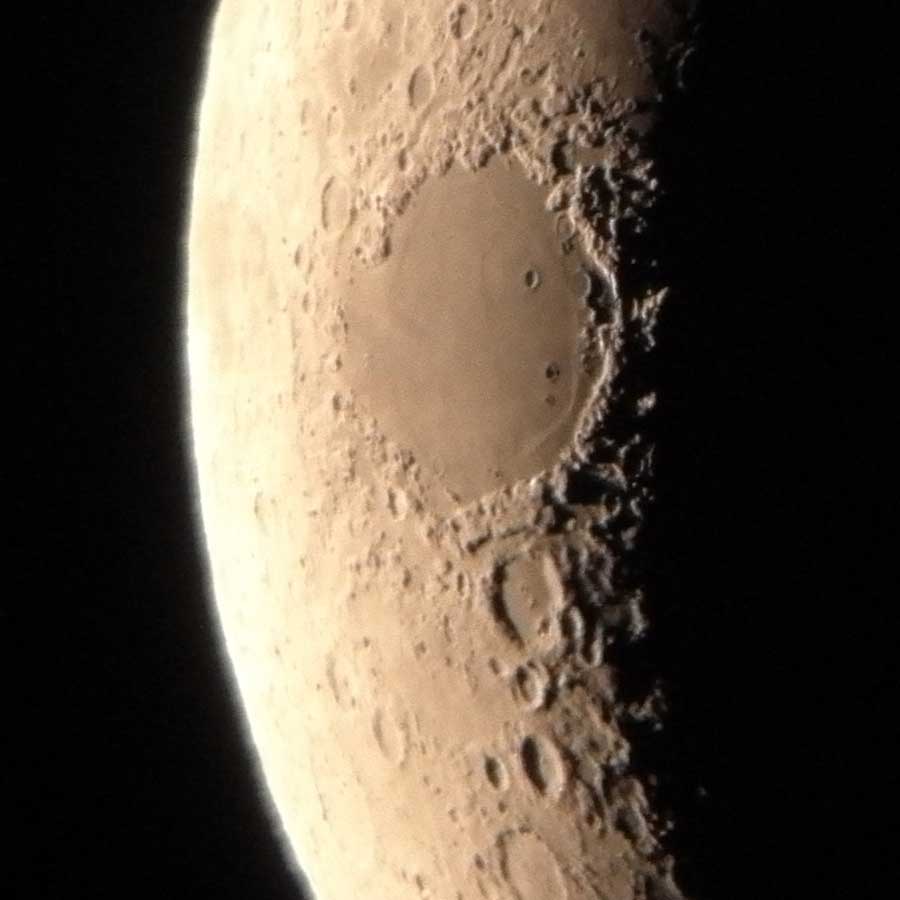 |
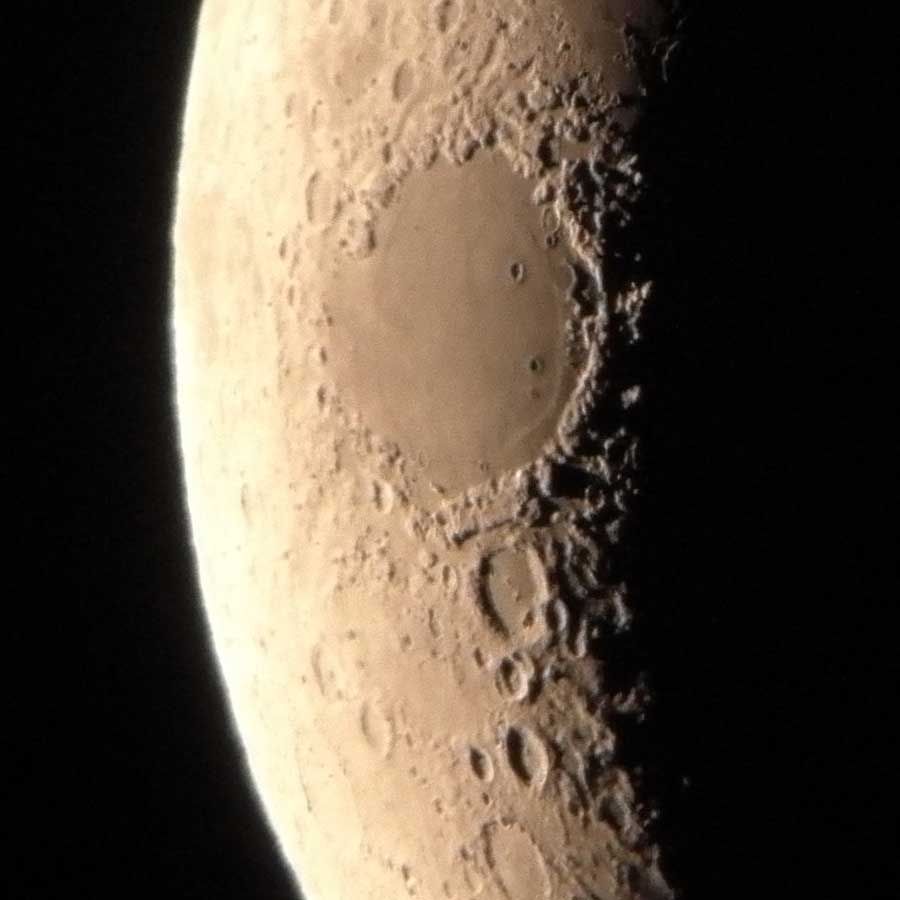 |
Photos with 16 mm Eyepiece (1:50 Method)
For the following moon photo attempts, I held the Leica X Vario to the 16 mm eyepiece (1:50 method). The telescopic magnification was 75 x, the camera lens was set to a focal length of 70 mm (= 46 mm actual) (I think...).
 |
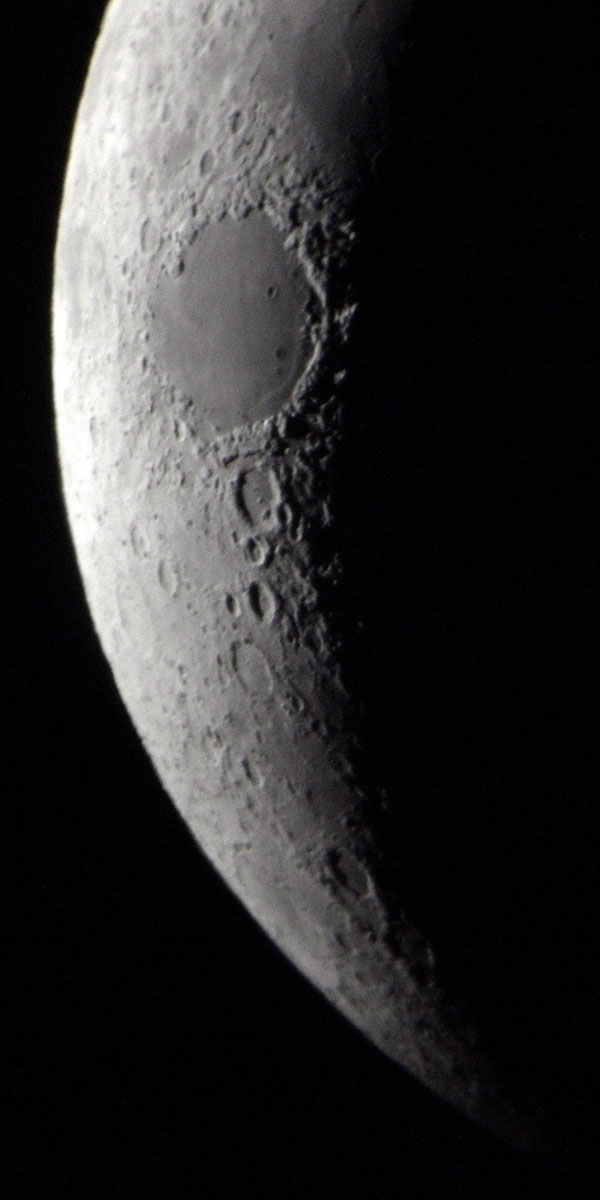 |
 |
Conclusions
My first impression of the GSD GSD 680 telescope was very positive, even though it was based almost exclusively on observations of the Jupiter and the Orion Nebula under poor conditions. I believe that I had never seen both objects so well with my other telescopes as with the GSD 680. Soon after, I was also able to observe and take photos of the moon, which surprised me pleasantly. I also was able to look at a few bright deep sky objects in summer/autumn 2016 and in spring 2017. Here, my impression was also very positive, although the number of observed sky objects that I visited with this telescope was rather limited.
All in all, I did not regret having bought the telescope. Regrettably, however, it turned out over time that this 8" telescope was still too heavy for me, so that I parted with it again after about a year...
Supplement
In early April 2017, I therefore bought 6" Newton tube, a Sky-Watcher Explorer 150PDS 150 mm / 750 mm (f/5), and it makes a good impression on me. I hoped that I might use a light-weight 6" telescope also on my Sky-Watcher Star Discovery AZ GoTo mount. I did so in the meantime, but this seems to be a "borderline case " - I do not know whether the engine and the gearbox will last long under this heavy load. But it does work at the moment... More on this on page Sky-Watcher Star Discovery AZ GoTo Mount - Adaptation to Heavier Loads.
When I still owned both telescopes, I did a "quick comparison" with the 6" Explorer 150PDS tube using the targets M 42/43 and M 35 (April 9, 2017). Since my eyepieces did not allow me to use both telescopes at the same magnification in parallel, such a comparison was, of course, problematic. All in all and not surprisingly, the view through the GSD 680 looked brighter and more contrasty to me, but the Explorer PDS150 was not bad either. Before this test, I was actually prepared to sell the GSD 680, but this comparison made me somewhat undecided... In the end, however, I parted with the GSD 680, as nice as it was, because it was definitively too heavy for me. I gave it to a dealer on sale or return at the end of April 2017, and he sold it for me.
Links
- GSO Company Website, Taiwan: www.gs-telescope.com
GDS680 page on the GSO Website: www.gs-telescope.com/content.asp?id=116 - Video showing the assembly of the telescope (10" version): www.zhumell.com/telescopes/dobsonian/z8-dobsonian-telescope/
- Pages of German dealers who sell the GSD 680 telescope:
- Astroshop : www.astroshop.de/gso-dobson-teleskop-n-200-1200-dob-deluxe-version/p,14189 (German) - http://www.astroshop.eu/gso-dobson-telescope-n-200-1200-dob-deluxe-version/p,14189 (English)
- Teleskop-Service (here I bought the telescope): http://www.teleskop-express.de/shop/product_info.php/info/p1191_GSO-8-Zoll-f-6-Dobson-Teleskop-Deluxe-mit-verbesserter-Ausstattung.html (German) - www.teleskop-express.de/shop/product_info.php/language/en/info/p1191_GSO-8-Zoll-f-6-Dobson-Teleskop-Deluxe-mit-verbesserter-Ausstattung.html (English)
- Teleskop-Spezialisten: www.teleskop-spezialisten.de/shop/Dobson/200mm-8-Zoll/GSD 680-GSO-680-oder-REVELATION-Dobson-8-200-1200mm-Teleskop-Deluxe-Premium-Version::340.html (German)
- 8" Dobson: GSO oder Skywatcher? (astronomie.de, loginov): forum.astronomie.de/phpapps/ubbthreads/ubbthreads.php/topics/777979/8_Dobson_GSO_oder_Skywatcher (German)
- See also my page offering Astronomy Links.
Appendix: Data for GSD 680 Telescope
| Telescope: GSO | GSD 680 |
| Optical Design | Newton (Parabolic) |
| Primary Mirror Diameter | 200 mm (8") |
| Focal Length, Focal Ratio | 1200 mm, f/6 |
| Resolving Power (arc secs) | 0.58" |
| Limiting Visual Stellar Magnitude | 14.5 mag |
| Light Gathering Power | 816.3 |
| Maximum Practical Visual Power | ca. 300 x (400 x) |
| Optical Tube Dimensions (diam. x length) | 23 cm x 115 cm |
| Net Weight Basis | 11.2 kg |
| Net Weight Optical Tube | 9.5 kg |
| Net Weight Complete | appr. 21 kg |
Dark Blue: Telescopes that I still own; italic and dark red: telescopes that I owned; black: for comparison; *) own measurement
See also the table of data for all of my telescopes (and a few more...)
| 08.01.2020 |

